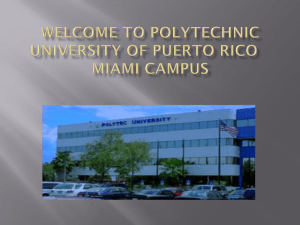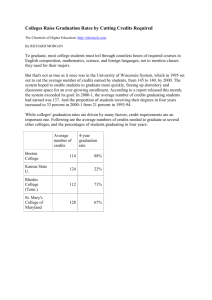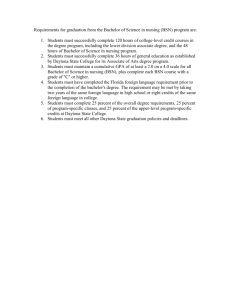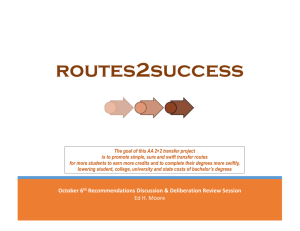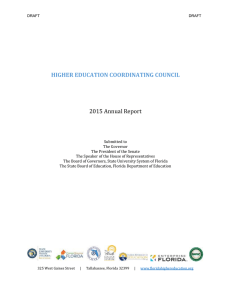Access to Bachelor Degrees in Florida * The Next 30 Years
advertisement
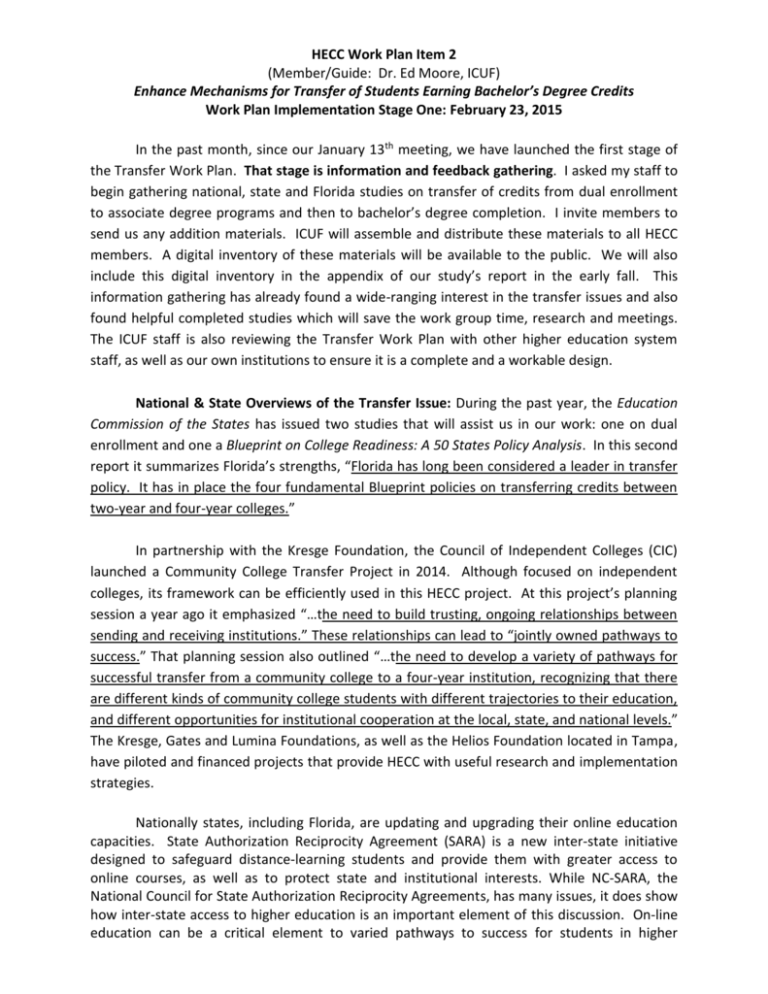
HECC Work Plan Item 2 (Member/Guide: Dr. Ed Moore, ICUF) Enhance Mechanisms for Transfer of Students Earning Bachelor’s Degree Credits Work Plan Implementation Stage One: February 23, 2015 In the past month, since our January 13th meeting, we have launched the first stage of the Transfer Work Plan. That stage is information and feedback gathering. I asked my staff to begin gathering national, state and Florida studies on transfer of credits from dual enrollment to associate degree programs and then to bachelor’s degree completion. I invite members to send us any addition materials. ICUF will assemble and distribute these materials to all HECC members. A digital inventory of these materials will be available to the public. We will also include this digital inventory in the appendix of our study’s report in the early fall. This information gathering has already found a wide-ranging interest in the transfer issues and also found helpful completed studies which will save the work group time, research and meetings. The ICUF staff is also reviewing the Transfer Work Plan with other higher education system staff, as well as our own institutions to ensure it is a complete and a workable design. National & State Overviews of the Transfer Issue: During the past year, the Education Commission of the States has issued two studies that will assist us in our work: one on dual enrollment and one a Blueprint on College Readiness: A 50 States Policy Analysis. In this second report it summarizes Florida’s strengths, “Florida has long been considered a leader in transfer policy. It has in place the four fundamental Blueprint policies on transferring credits between two-year and four-year colleges.” In partnership with the Kresge Foundation, the Council of Independent Colleges (CIC) launched a Community College Transfer Project in 2014. Although focused on independent colleges, its framework can be efficiently used in this HECC project. At this project’s planning session a year ago it emphasized “…the need to build trusting, ongoing relationships between sending and receiving institutions.” These relationships can lead to “jointly owned pathways to success.” That planning session also outlined “…the need to develop a variety of pathways for successful transfer from a community college to a four-year institution, recognizing that there are different kinds of community college students with different trajectories to their education, and different opportunities for institutional cooperation at the local, state, and national levels.” The Kresge, Gates and Lumina Foundations, as well as the Helios Foundation located in Tampa, have piloted and financed projects that provide HECC with useful research and implementation strategies. Nationally states, including Florida, are updating and upgrading their online education capacities. State Authorization Reciprocity Agreement (SARA) is a new inter-state initiative designed to safeguard distance-learning students and provide them with greater access to online courses, as well as to protect state and institutional interests. While NC-SARA, the National Council for State Authorization Reciprocity Agreements, has many issues, it does show how inter-state access to higher education is an important element of this discussion. On-line education can be a critical element to varied pathways to success for students in higher education under-served communities, as well as non-traditional students. Florida’s efforts for non-completers led by the University of West Florida is reflective of this potential. Many states are, like Florida, also reviewing their transfer designs. California’s current efforts to reform its inter-institutional design may be the most helpful example for this HECC project. Although California is in some ways trailing Florida, its public, independent and private institutions are similar to Florida. The size and challenges of its student population mirrors Florida’s own growing student population. They have found that despite several upgrades and updates of their transfer design, “Unfortunately, transfer students often navigate a maze of academic requirements that vary across campuses, complicating their ability to earn a bachelor’s degree within 120 semester units (four years of full-time coursework).” A windfall to this HECC project was the February 17 th workshop at the House Education & Workforce Subcommittee. The video record session and its materials included a General Accreditation Overview presented by Dr. Arthur Keiser, Chancellor of Keiser University; an outline of the Southern Association of Colleges & Schools by Dr. Ed Meadows, President of Pensacola State College; the Council on Occupational Education by Dr. Gary Puckett of the COE; and a summary of transfer credits by our Mathew Bouck. Several HECC members attended this session or watched the video broadcast. We are using that meeting and materials as an element of our review and will enable other members to access this session. It was an exceptionally instructive review and discussion of inter-system transfer issues. Feedback on the Work Plan & Expansion of the Work Plan Scope: We have received several helpful suggestions to address gaps in the work plan “pathways” work to increase number & proportion of transfer students earning bachelor’s degree credits which will be added to the next work plan draft for our March HECC meeting. Those suggestions include: Although the challenge presented by this study is to focus on AA to BA type transfer, we intend to also include the beginnings of an analysis of College and Adult Education Programs to determine any transfer of credits leading to bachelor’s degrees issues, especially Career and Professional Academies; Address Associate of Arts Degree Credits that lead to a bachelor’s degree, with some leading tangents that can be picked up in a subsequent study on issues related to AS programs and their transferability to BS degree programs; and Analyze available capacities, both statewide and regionally, to enroll what could be an increasing number of students with transferable credits, leading to a bachelor’s degrees. We will also include discussion of how credits might be obtained at the secondary levels and potential obstacles to recognition of these credit paths. Looming Problems: As this project proceeds, there is a looming problem: the multiple, competing and conflicting goals of Washington, Tallahassee and even HECC. USDOE is pressing on student loan defaults, as well as grading higher education institutions. This may compel some higher education institutions to be less inclined to accept transfer students, preferring to focus on traditional four year bachelor’s degree enrollments. In addition, free community college tuition may focus on terminal workforce, job-placement degrees and not transferrable credits which lead to a bachelor’s degree. Likewise Florida’s focus on performance measurement at higher education institutions may lead institutions to raise their acceptance requirements and lower their inclination to enroll students that are not taking the institution’s entire four year curriculum. Keep in mind that the traditional calculation of graduation rates runs counter to the notion that students can easily transfer since students who transfer count against the success rate of institutions, even if they complete degrees. These are looming but manageable problems. Stage Two – Data Collection: We will complete this informational and feedback stage by the next HECC meeting in March. After completing this first stage, we will convene the system staff, some institutional staff and HECC members who are available to begin collecting institutional and inter-institutional data. We will plan to minimize demands on staff and institutions to generate this necessary data. By the Florida Association of Colleges and Universities Annual Meeting in June, we hope to review this project for further institutional feedback and support. Our goal for a final Transfer Study Report will be September.


